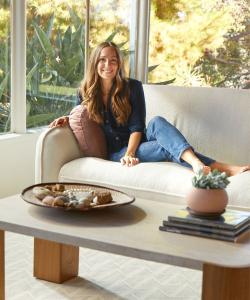

Sometimes the need for a new brand is obvious. That’s how Parachute founder Ariel Kaye felt when she couldn’t find a single home goods brand she felt was high quality, fashionable and affordable.
Kaye founded Parachute in 2014 as an online-only, direct-to-consumer brand focused on impeccable bedding. The company has since evolved into many other areas of the home and expanded into 26 bricks-and-mortar stores across the United States. NRF contributing writer Bruce Horovitz spoke with Kaye about where Parachute goes from here.
Why is your home goods company named Parachute?
It’s an idea inspired by the moment of sheets when you make a bed. I wanted something that was different and gender neutral and evocative of billowing sheets.
What makes Parachute different from other home brand companies?
I had an idea to focus on comfort and quality and to think about the customer first. We have created a product assortment that speaks to customer needs and wants. We use data to continue to develop products that keep people coming back. We don’t focus on shifting styles or trends. We even offer top sheets as optional because 40% of Americans sleep without a top sheet. Why pay for something you don’t use?
How is the Parachute brand different from, say, Martha Stewart?
I’m a huge fan of hers. She has products in the entire home category. Martha is an iconic figure who has pioneered so much in the home. I never really considered how we are similar and different. I don’t see that our brands have much crossover. Her product assortment is so broad. I think of her more in cookware and tabletops and recipes. We’re more into bedding and bath. We don’t think of them as competitors.
How does your mission of sustainability show up in your products?
It’s central to everything we’ve done since the beginning. The customer demands it. It’s our responsibility to take care of the planet. We think about sustainability in everything from our packaging to making sure there are no “forever chemicals” used in our furniture. We have one planet, and we have to take care of it. I grew up in a family that was committed to service and to taking care of the planet. It’s a core pillar of who we are.
Who is your target?
Millennials are a big focus for us. They buy products recommended by social media influencers and buy a lot online.
Parachute has Venice Beach (Calif.) beginnings. How has that beach culture specifically impacted the brand?
I was born and raised in Venice Beach. That’s where I grew up. The idea for the brand came when I was living in New York, but I knew that I had to return to LA to launch the brand and move home to Venice. I am inspired by the laid-back vibe and the sense of community in Venice. Our color patterns mirror coastal living. You can often see that our styling favors a perfectly undone look. The Venice lifestyle has become part of our DNA. You see that in our sunset and coastal beach hues. Being in such an outdoor community is a source of inspiration.
Parachute started with basics but has since expanded to a much larger brand. Why?
We always intended to be a multi-dimensional modern home lifestyle brand. We decided to start with bedding and sheets because I thought I could help create a beautiful sleep experience that would be so important to gaining momentum in the wellness category. I knew if the brand could be part of the (wellness) conversation, I could gain the trust of customers and move beyond the bedroom. It was important to build trust and get a customer base that we could leverage for organic growth. We’ve been very deliberate in our growth.
Did your advertising background have something to do with that?
My background is in advertising, so I know how to connect with customers and understand where the opportunities are. In the beginning, we had so many inquiries from our customers who would ask us where to buy the best mattresses or bed frames or pillows. It became obvious that we earned the trust of our customer base. Building a brand doesn’t happen overnight. It’s about building the brand over time in order to have a lasting impact on customers.
Parachute started as an online-only, direct-to-consumer company. What changed?
We always knew we’d move offline. We started online because that’s how to reach the most customers in the most effective way as opposed to opening stores in different locations. Being online first helped us to collect a ton of data about our customers. For our first 10 years, some 90% of our purchases have been offline. You can’t change behavior overnight. I felt that retail locations would help us to connect with customers who could come see our products in person and become advocates. We have to be where our customers are, and they are both online and offline.

What are your bricks-and-mortar growth plans?
We currently have 26 stores across the U.S. and believe that we could have 100 to 150 over the long term. We don’t franchise anything. All stores are owner operated.
How do you decide where to open a bricks-and-mortar store?
First, we look at online sales. Where do customers who are buying our stuff live and work? What are the markets that have growth opportunities? Where do we see the potential to build a customer base? We also look for the right co-tenants to surround ourselves with.
Which co-tenants do you like best?
It’s a mix. We often find ourselves near Warby Parker and Allbirds. We also like ice cream shops near us because ice cream brings a smile to your face. We like to be in a mix of retail and food and beverage.
You recently opened a flagship store in New York City. How is that doing?
It’s such a beautiful store. I was there for the opening. Because it’s a flagship location on Fifth Avenue between 17th and 18th, we chose new design choices to make it special. The store is doing great.
Since your product line is expanding, does that mean your bricks-and-mortar locations need to be a bit larger?
No. Our stores are from 700 square feet to 4,000 square feet. Our sweet spot is 2,000 square feet.
Is Nordstrom selling some Parachute products?
Nordstrom is our first major wholesale partner. We have an assortment on nordstrom.com and are currently at 13 Nordstrom locations. Our customers are very much aligned.
Do you have links to any other major retailers?
Not currently. But we’re always open to conversation.
You have said that Parachute’s footprint doubled in 2022. How?
We had 12 locations in 2021 and opened 13 more in 2022. We decided to invest deeply in retail in 2022. It’s been great to see these stores gaining momentum and getting established in their neighborhoods. Omnichannel shopping is the path forward.
How are you paying for all this growth?
We are funding our own expansion. We originally raised $47 million but it’s been five years since we’ve needed any outside capital. Few have done this with so little capital.

How was Parachute impacted by the pandemic?
It was very positive for us. At the time, everyone was stuck at home and looking at their homes in a new way. The home was no longer just a place to sleep or to have dinner but a place to spend most of your time, so people began investing in their homes to make them more practical. As stores shut down during the pandemic, everyone went online (which is where we were.) Because we are digital natives, that sets us up for success. Also, most of the products we make come from Europe (Portugal and Turkey), so we didn’t have supply chain issues like retailers importing from Asia. We were actually able to accelerate new launches and bring in new products. Sure, there were challenges, but we saw incredible success during COVID-19.
How do you attract customers to your retail locations post-COVID?
With “Welcome Back” events of all kinds. That’s why I love retail and physical stores. It’s about relationships. We are part of a community and it’s not just about transactions. We’ve always hosted special events and prioritized them. They increase average sales and store traffic and attract first-time customers. Now, we’re doing many more panels and workshops and having speakers in stores. We also host parties and monogramming events, and we like to surprise and delight customers with treats and drinks when they are shopping.
How important is technology to Parachute?
Tech is the differentiator for us. We’ve been able to think about the customer in a very specific way because we have a lot of data on them. Tech is the foundation for building enduring brands. We build our website with limitless customization and personalization. We are now faced with harnessing new tech like the power of AI to enhance our marketing. We are trying to figure out the future of tech and stay ahead of the curve.
What are your big product lines right now?
Bedding, pillows, bath, towels, bathmats, robes, window treatments, mattresses, loungewear, furniture, throws, and baby bedding and bath.
Check out NRF's Retail Gets Real podcast to hear more from Ariel Kaye on growing the Parachute brand.
What’s next?
We have lots of ideas up our sleeves. You’ll have to wait and see.
Is your goal for Parachute to be a household name?
We will be a household name. We’re coming up on our 10th anniversary in January. Our brand awareness increases quarter over quarter. Retail is a big part of that strategy. We are doing it without marketing gimmicks. We’re building a brand in a healthy, deliberate and thoughtful way. I plan on my grandkids shopping for Parachute.
Parachute aims to be fashionable, sustainable — and affordable. If one of those three ultimately has to give, which one will it be?
We’re not compromising on any of those. We’ve been fashionable, sustainable and affordable for 10 years. We don’t launch anything that doesn’t check all three boxes.
If you could only bring one of your products to a desert island, what would it be?
Either the Parachute Cloud Cotton Robe because it’s the best on the market or the Parachute Linen Box Quilt which is a classic weight for sleeping and lounging and makes a good picnic blanket, too.
What’s your best tip to other retail execs — or entrepreneurs — who want to mirror your success?

One of the most important lessons for me is understanding my strengths and being super-hyper-aware of my weaknesses. It’s a superpower to raise your hand and ask for help. The quicker you do that the more quickly you can make the changes you need to make. Hire people you can trust and who take accountability. Hire self-starters who look at challenges as opportunities.
What did you learn most from your marketing background?
It’s all about understanding customers and building relationships. It’s always about putting the customer first. Listen and learn from them and grow with them. Always make the experience more personalized. We want customers to feel inspired and to purchase with the confidence that things will be fixed if they’re not happy.
How is the retail world changing?
There’s a lot of uncertainty right now. As long as you maintain core values there is an opportunity for growth. It’s never been a sprint, it’s always been a marathon. Strong brands emerge from challenging times. It’s a great opportunity to make difficult decisions for long-term success.





